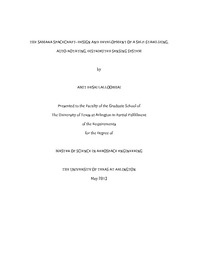
ATTENTION: The works hosted here are being migrated to a new repository that will consolidate resources, improve discoverability, and better show UTA's research impact on the global community. We will update authors as the migration progresses. Please see MavMatrix for more information.
Show simple item record
| dc.contributor.author | Lalloobhai, Amit Desai | en_US |
| dc.date.accessioned | 2013-07-22T20:15:06Z | |
| dc.date.available | 2013-07-22T20:15:06Z | |
| dc.date.issued | 2013-07-22 | |
| dc.date.submitted | January 2013 | en_US |
| dc.identifier.other | DISS-12197 | en_US |
| dc.identifier.uri | http://hdl.handle.net/10106/11871 | |
| dc.description.abstract | The scope of this research is the design and development of a self-stabilizing re-entry vehicle that closely resembles naturally occurring seeds in nature. It was hypothesized that a femto-satellite with a shape of a samara could self stabilize and passively generate lift, as well as transmit a signal during its descent through the atmosphere. The research included a conceptual design phase and a preliminary design phase that entailed analytic simulations, and an experimental demonstration. The goal was to investigate the feasibility of developing the above-mentioned femto-vehicle that could increase the range capability of its descent to maximize data capture. | en_US |
| dc.description.sponsorship | Harris, Ben | en_US |
| dc.language.iso | en | en_US |
| dc.publisher | Aerospace Engineering | en_US |
| dc.title | The Samara Spacecraft: Design And Development Of A Self-stabilizing, Auto-rotating, Distributed Sensing System | en_US |
| dc.type | M.S. | en_US |
| dc.contributor.committeeChair | Harris, Ben | en_US |
| dc.degree.department | Aerospace Engineering | en_US |
| dc.degree.discipline | Aerospace Engineering | en_US |
| dc.degree.grantor | University of Texas at Arlington | en_US |
| dc.degree.level | masters | en_US |
| dc.degree.name | M.S. | en_US |
Files in this item
- Name:
- Lalloobhai_uta_2502M_12197.pdf
- Size:
- 28.51Mb
- Format:
- PDF
This item appears in the following Collection(s)
Show simple item record


